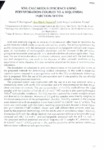Use este identificador para citar ou linkar para este item:
http://www.alice.cnptia.embrapa.br/alice/handle/doc/45116| Título: | Soil calcareous efficiency using pervaporation coupled to a sequential injection system. |
| Autoria: | KAMOGAWA, M. Y.  NOGUEIRA, A. R. de A.   ARTIGAS, J.   ALONSO, J.   |
| Afiliação: | MARCOS Y. KAMOGAWA, UFSCAR ANA RITA DE ARAUJO NOGUEIRA, CPPSE JUDIT ARTIGAS, UNIVERSITAT AUTNNOMA DE BARCELONA JULIÁN ALONSO, UNIVERSITAT AUTNNOMA DE BARCELONA. |
| Ano de publicação: | 2000 |
| Referência: | In: INTERNATIONAL CONFERENCE ON FLOW ANALYSIS, 8., 2000, Warsaw. Warsaw: Polish Chemical Society, 2000. p.147. |
| Conteúdo: | Acid soils normally require an amount of calcareous or other base to neutralise tlse acidity from the initial acidity occurs to selected less acidity. The following between theacidity components; with the enhanced amounts of exchangeable calcium and magnesium, an inactivation of exchangeable aluminium and the increase of the pH occur, giving most favourable plant growth. It is attained with the calcareous application. Huwever, the use of excessive doses of calcium carbonate, associated with the bad distribution and incorporation, can result in the decrease of other nutrients' readiness or the occurrence of some diseases. It is also sometime altered on the basis of economic con-siderations. The disolution of carbonate in acid and determination of the evolved CO> is one of the proposed methods for determining residual calcareous. In this work a sequential injection system coupled to a pervaporation unit for the CO ondutimetric determination is proposed. With the use of the pervaporation unit it was possible the use of soljQ samples without previous treatment. The proposed system was constructed with the use of a six way solenoid valve, a conductivity meter with an RS 232 connection and a PC microcomputer for data acquisition and externa! controls. The pre-concentration of the CO> evolved from the solid samples with the injection of 5.0 mL of 1.0 mol L ' HCI was done after passing through a Teflon" hydrophobic membrane. The COz was then captured by a water acceptor stream and directed to the detector. Amounts of 3.0 g of dry samples were directly weighted in the donor compartment of the pervaporation chamber. The CO~ amounts in the samples were determined with an analytical curve from 5.0x10 ' to 5.0x10' mol L ' of CO>. This curve was constructed with the matrix matching approach and showed a linear regression y=13.58+5S4.77x(R'=0.9962). Eleven soils with different lime amounts were analysed by the proposed methodology and the results were in accordance (slope 1.02+0.03; intersection 6+7) with the official method, that uses calcium difference between the total, extracted with HCI 1.0 mol L ' and exchangeable, extracted with the KCI 1.0 mol L '. The proposed method presented analytical frequency of 17 samples h ', detection lirnit of 8.0x10 ' mol L' of CO> and rsd < 3%, and the possibility of the residual calcare<ius determination without samples pre-treatment. |
| Thesagro: | Calcário Solo |
| Palavras-chave: | Soil Calcareous Sequential injection System Injeção seqüencial Sistema |
| Tipo do material: | Resumo em anais e proceedings |
| Acesso: | openAccess |
| Aparece nas coleções: | Resumo em anais de congresso (CPPSE)  |
Arquivos associados a este item:
| Arquivo | Descrição | Tamanho | Formato | |
|---|---|---|---|---|
| digitalizar0003.pdf | 449,09 kB | Adobe PDF |  Visualizar/Abrir |









